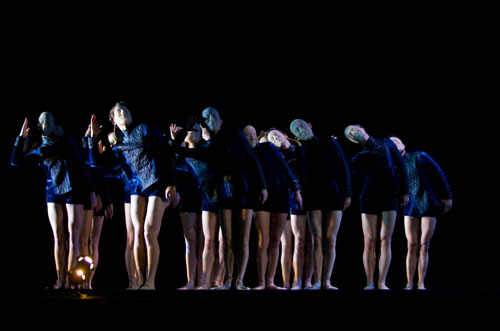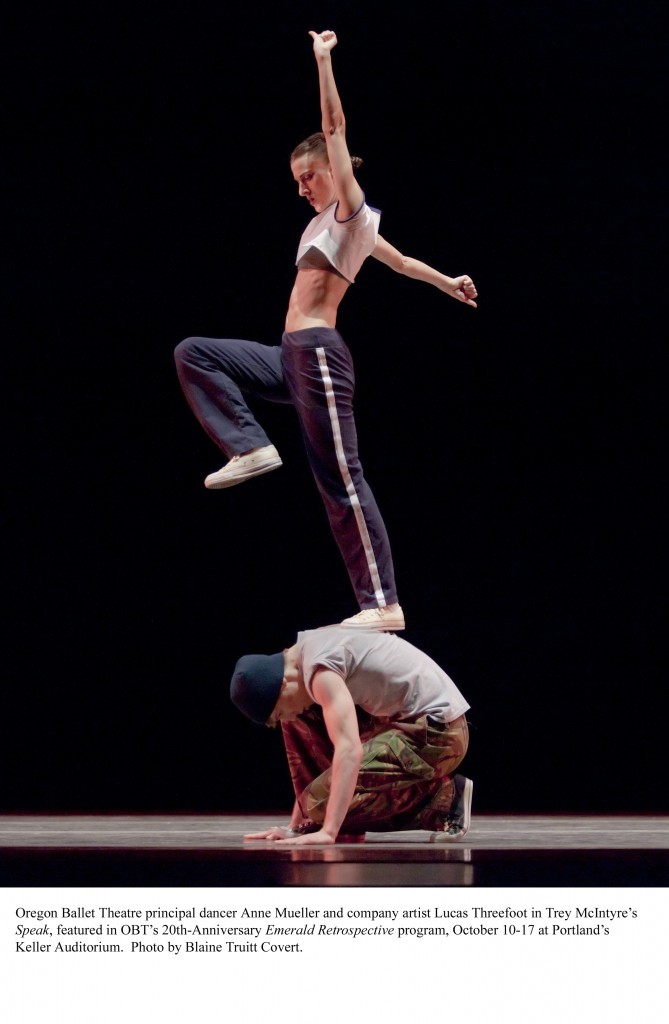Martha Ullman West, Art Scatter’s esteemed global correspondent for the terpsichorean arts, files this report from last night’s action in the balletic trenches of Mississippi — that is, North Mississippi Street in Portland. Sounds like a good place to move your feet tonight or tomorrow:
 Last night at Mississippi Studios, where six of Oregon Ballet Theatre’s dancers were performing the first of three nights of a sweet little show that company soloist Candace Bouchard whipped up in a couple of weeks, I couldn’t help thinking about George Balanchine.
Last night at Mississippi Studios, where six of Oregon Ballet Theatre’s dancers were performing the first of three nights of a sweet little show that company soloist Candace Bouchard whipped up in a couple of weeks, I couldn’t help thinking about George Balanchine.
Not as choreographer, although Bouchard, who was choreographing for the first time, produced some more than adquate steps to be performed on an extremely small platform.
 Rather, because history is to some degree repeating itself.
Rather, because history is to some degree repeating itself.
After the 1917 Bolshevik revolution Balanchine and his mates, including his first wife, Tamara Geva, danced in after-hours nightclubs in Petrograd in exchange for a pound of sugar or a loaf of bread.
Food shortages were rampant, the currency was in flux, and there was nothing to buy if you had any money in the first place.
 OBT’s dancers are not starving, and they’re not coping with food shortages caused by a revolution, although they are calling a projected series of performances in nontraditional spaces Uprising. This program, which repeats tonight and tomorrow, is the first. But Bouchard, soloists Stephen Houser and Ansa Deguchi, and company artists Leta Biasucci, Olga Krochik and Lucas Threefoot have been off-contract at OBT since the Emeralds season-opener, and they are definitely dancing to put food on their tables.
OBT’s dancers are not starving, and they’re not coping with food shortages caused by a revolution, although they are calling a projected series of performances in nontraditional spaces Uprising. This program, which repeats tonight and tomorrow, is the first. But Bouchard, soloists Stephen Houser and Ansa Deguchi, and company artists Leta Biasucci, Olga Krochik and Lucas Threefoot have been off-contract at OBT since the Emeralds season-opener, and they are definitely dancing to put food on their tables.
 And dancing very well, to a large degree because they were dancing to live music, the often infectious beat produced by the indie folk band Horse Feathers.
And dancing very well, to a large degree because they were dancing to live music, the often infectious beat produced by the indie folk band Horse Feathers.
In the show’s first half they were clearly having a very good time, whipping off some pirouettes, rising to the occasion of a very small stage (platform, really, but at least it was wood and they weren’t dancing on cement) with, in Threefoot’s case, some jetes that came close to being grand.
 Bouchard, whose goal was to make classical ballet user-friendly, did not patronize her audience. Incorporated into the choreography were difficult fifth positions and some complicated lifts.
Bouchard, whose goal was to make classical ballet user-friendly, did not patronize her audience. Incorporated into the choreography were difficult fifth positions and some complicated lifts.
The second half dragged a bit, in part because of the level tone of the music, although Bouchard managed to get all six dancers onto the stage at once in a perfectly viable pattern of movement to end a show that was charming and thoughtfully conceived, and that got a well-deserved rousing ovation from an audience in which I recognized very few faces.
 It’s a generous performance, danced with the same heart these dancers put into their OBT work, and the close quarters of Mississippi Studios give even seasoned ballet-goers a fresh perspective on the dancers’ talent. Company dancer Grace Shibley was represented by some simple costumes, incidentally, in which the dancers could move well, although I could have done without the spangles on Houser’s vest.
It’s a generous performance, danced with the same heart these dancers put into their OBT work, and the close quarters of Mississippi Studios give even seasoned ballet-goers a fresh perspective on the dancers’ talent. Company dancer Grace Shibley was represented by some simple costumes, incidentally, in which the dancers could move well, although I could have done without the spangles on Houser’s vest.
Uprising (no connection to Hofesh Schechter’s piece of the same name) will be repeated tonight and tomorrow night (Wednesday and Thursday) at 8 p.m. at Mississippi Studios, 3939 N. Mississippi St. Catch it if you can.
PHOTOS, from top: Candace Bouchard, Lucas Threefoot, Ansa Deguchi, Leta Biasucci, Stephen Houser, Olga Krochik. Courtesy OBT.
 James McGrew
James McGrew Last night at Mississippi Studios, where six of Oregon Ballet Theatre’s dancers were performing the first of three nights of a sweet little show that company soloist Candace Bouchard whipped up in a couple of weeks, I couldn’t help thinking about George Balanchine.
Last night at Mississippi Studios, where six of Oregon Ballet Theatre’s dancers were performing the first of three nights of a sweet little show that company soloist Candace Bouchard whipped up in a couple of weeks, I couldn’t help thinking about George Balanchine. Rather, because history is to some degree repeating itself.
Rather, because history is to some degree repeating itself. OBT’s dancers are not starving, and they’re not coping with food shortages caused by a revolution, although they are calling a projected series of performances in nontraditional spaces Uprising. This program, which repeats tonight and tomorrow, is the first. But Bouchard, soloists Stephen Houser and Ansa Deguchi, and company artists Leta Biasucci, Olga Krochik and Lucas Threefoot have been off-contract at OBT since the Emeralds season-opener, and they are definitely dancing to put food on their tables.
OBT’s dancers are not starving, and they’re not coping with food shortages caused by a revolution, although they are calling a projected series of performances in nontraditional spaces Uprising. This program, which repeats tonight and tomorrow, is the first. But Bouchard, soloists Stephen Houser and Ansa Deguchi, and company artists Leta Biasucci, Olga Krochik and Lucas Threefoot have been off-contract at OBT since the Emeralds season-opener, and they are definitely dancing to put food on their tables. And dancing very well, to a large degree because they were dancing to live music, the often infectious beat produced by the indie folk band Horse Feathers.
And dancing very well, to a large degree because they were dancing to live music, the often infectious beat produced by the indie folk band Horse Feathers. Bouchard, whose goal was to make classical ballet user-friendly, did not patronize her audience. Incorporated into the choreography were difficult fifth positions and some complicated lifts.
Bouchard, whose goal was to make classical ballet user-friendly, did not patronize her audience. Incorporated into the choreography were difficult fifth positions and some complicated lifts. It’s a generous performance, danced with the same heart these dancers put into their OBT work, and the close quarters of Mississippi Studios give even seasoned ballet-goers a fresh perspective on the dancers’ talent. Company dancer Grace Shibley was represented by some simple costumes, incidentally, in which the dancers could move well, although I could have done without the spangles on Houser’s vest.
It’s a generous performance, danced with the same heart these dancers put into their OBT work, and the close quarters of Mississippi Studios give even seasoned ballet-goers a fresh perspective on the dancers’ talent. Company dancer Grace Shibley was represented by some simple costumes, incidentally, in which the dancers could move well, although I could have done without the spangles on Houser’s vest.
 “How do they dance up on their toes like that?” he asked. “Do they have to work a lot to do it? That must be hard!”
“How do they dance up on their toes like that?” he asked. “Do they have to work a lot to do it? That must be hard!”